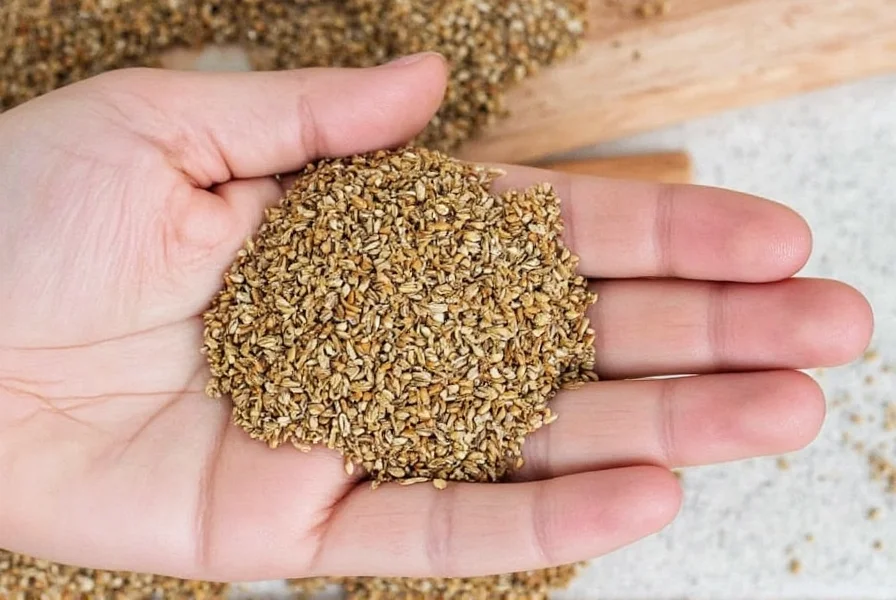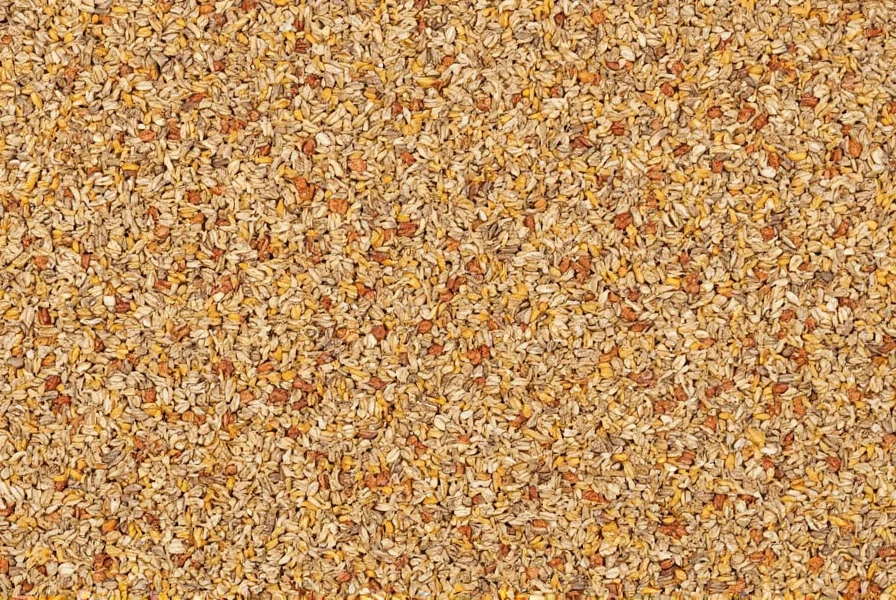Table of Contents
Introduction to Caraway Seeds
Caraway seeds are the dried fruits of the Carum carvi plant, belonging to the Apiaceae (parsley) family. Despite their name, they are technically fruits, not seeds. These small, crescent-shaped seeds have been used for centuries in European and Middle Eastern cuisines, adding a warm, nutty flavor with distinct anise undertones to dishes like rye bread, sausages, and cheeses.
Caraway seeds are not just a spice—they’re a versatile culinary ingredient that enhances both savory and sweet recipes. In this guide, we’ll explore their origins, flavor characteristics, practical cooking applications, and how to select the highest quality seeds for your kitchen.
The Flavor Profile of Caraway Seeds
Caraway seeds deliver a complex flavor profile: warm, nutty, slightly sweet, with a pronounced anise or licorice note. This unique combination makes them stand apart from similar spices like cumin or fennel. When ground, they release a stronger, more pungent aroma, but when used sparingly, they add depth without overpowering dishes.
Here’s how caraway compares to common spice alternatives:
| Spice | Flavor Profile | Common Uses |
|---|---|---|
| Caraway Seeds | Earthy, nutty, slightly sweet, with a hint of anise | Breads, stews, sausages, cheeses |
| Fennel Seeds | Sweet, licorice-like, herbal | Italian sausages, breads, teas |
| Cumin | Earthy, warm, slightly bitter | Mexican, Indian, Middle Eastern dishes |
| Coriander | Lemony, citrusy, slightly sweet | Indian curries, soups, sauces |
Cooking Uses and Popular Dishes
Caraway seeds are incredibly versatile and can be used whole or ground. Here are key culinary applications:
- Bread and Baking: Essential in traditional rye breads (German and Scandinavian), sourdough loaves, and seed-crusted artisan breads.
- Sauces and Stews: Enhances pork, beef, and root vegetable stews (e.g., German sauerbraten or Irish stew).
- Cheeses: Infused into aged gouda, cheddar, and other specialty cheeses for added complexity.
- Spiced Beverages: Used in herbal teas, mulled wine, and spiced rum for warm, aromatic notes.
- Seasonings: Blended with salt for rubs, or added to marinades for meats and roasted vegetables.
Buying Guide: How to Choose the Best Caraway Seeds
Follow these criteria to select premium caraway seeds:
Key Features to Look For
- Color: Light brown or golden—avoid dull or discolored seeds.
- Aroma: Strong, fresh scent; stale or musty smells indicate age.
- Texture: Dry and separate (not clumped), indicating proper storage.
- Origin: Prefer seeds from Europe (Germany, Netherlands) or Asia for authentic flavor profiles.
Recommended Products
- Organic Caraway Seeds (100g) – Ideal for health-conscious cooks. Features: USDA-certified organic, no additives, perfect for baking and seasoning.
- Ground Caraway Seed (50g) – Best for convenience. Features: Fine grind, ideal for soups, stews, and spice rubs.
- Caraway Seed Mix (200g) – For adventurous chefs. Features: Blended with complementary spices like cumin and coriander for complex flavor profiles.
Best Use Cases and Target Audience
Caraway seeds are perfect for home cooks exploring new flavors, professional chefs seeking unique touches, and bakers aiming to elevate traditional recipes. They shine in autumn and winter dishes—think hearty stews, holiday sausages, and festive breads—and work exceptionally well in vegetarian and vegan cooking to add depth to grain-based dishes and roasted vegetables.
Substitutes for Caraway Seeds
When caraway seeds are unavailable, these alternatives work best:
- Fennel Seeds: Closest match with sweeter licorice notes. Use 1:1 ratio for breads and fish dishes.
- Cumin: Warmer and earthier. Best for meat-based stews (use 50% less than caraway).
- Coriander: Citrusy and delicate. Ideal for curries and vegetable dishes (use 75% of the caraway amount).
- Anise Seeds: Intensely licorice-forward. Use sparingly in baked goods (50% of caraway quantity).
Always adjust quantities based on taste—substitutes will alter the dish’s flavor profile slightly.

Frequently Asked Questions About Caraway Seeds
What are caraway seeds exactly?
Caraway seeds are the dried fruits of the Carum carvi plant, belonging to the Apiaceae family. Despite their name, they’re technically fruits, not seeds. These small, crescent-shaped seeds have been used for centuries in European and Middle Eastern cuisines for their distinctive flavor.
What do caraway seeds taste like?
Caraway seeds have a warm, nutty, slightly sweet flavor with a pronounced anise or licorice undertone. When ground, they release a stronger aroma but remain balanced when used in moderation. They share similarities with cumin and fennel but have a more complex, rounded profile.
How do caraway seeds differ from cumin and fennel seeds?
Caraway seeds have a balanced earthy-nutty flavor with distinct anise notes. Cumin is warmer and more bitter, while fennel seeds are sweeter with stronger licorice characteristics. Visually, caraway seeds are smaller and more curved than cumin seeds and darker than fennel seeds.
What are the most common uses for caraway seeds in cooking?
Caraway seeds are essential in traditional rye breads (German and Scandinavian), aged cheeses like gouda, sausages, stews (especially pork and beef), and spiced beverages. They work well whole or ground and enhance both savory dishes and some baked goods.
How should I store caraway seeds to keep them fresh?
Store whole seeds in an airtight container in a cool, dark place for up to 2 years. Ground caraway retains freshness for 6 months. For extended storage, refrigerate or freeze to preserve aromatic oils and flavor intensity.
Can I substitute caraway seeds if I don’t have them?
Yes. Fennel seeds are the closest substitute (use 1:1 for breads), cumin works for meat dishes (use 50% less), coriander for citrusy notes (use 75% of the amount), and anise seeds for intense licorice (use 50% of the amount). Always adjust to taste.
Are caraway seeds and caraway the same thing?
Yes. "Caraway" refers to the seeds of the Carum carvi plant. In culinary contexts, "caraway" alone means the seeds, though "caraway seeds" specifies the spice form versus other plant parts.
Do caraway seeds have any health benefits?
Traditionally used for digestive support and bloating relief, caraway seeds contain antioxidants and antimicrobial compounds. They’re rich in minerals like iron and calcium. However, they should be consumed as part of a balanced diet—not as a medical treatment.
Conclusion
Caraway seeds are more than a spice—they’re a versatile culinary tool with deep historical roots and modern applications. Their unique earthy-anise profile elevates everything from traditional rye bread to contemporary vegetarian dishes. Whether you’re a home cook experimenting with new flavors or a professional chef refining recipes, caraway seeds offer a simple way to add depth and complexity to your cooking.
From their origins in European and Middle Eastern cuisines to their role in today’s global kitchens, caraway seeds remain a timeless ingredient. The next time you encounter them in a recipe, embrace their potential—your dishes will thank you.











 浙公网安备
33010002000092号
浙公网安备
33010002000092号 浙B2-20120091-4
浙B2-20120091-4